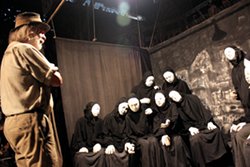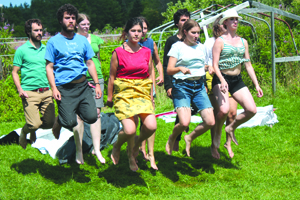

copyright the Chronicle August 13, 2014
by David Dudley
GLOVER — Before the Bread and Puppet Theater’s Friday night performance of Fire, Genevieve Yeuillaz rakes the dirt floor theater. Though the audience rarely acknowledges her effort, she carefully makes lines in the dirt before each performance. It’s a way of making the space feel fresh. The raking is, perhaps for Ms. Yeuillaz, a meditation, a kind of prayer. She focuses her attentions on a seemingly small, repetitive task to rest her mind before the intense performance.
Though there’s peace to be found in keeping with routine, the Bread and Puppet Theater has halted their regularly scheduled Friday evening program to present Fire, Emergency Performance for Gaza. The title reflects the re-envisioning of Fire, in response to what Peter Schumann calls “the American tax-dollar funded atrocities in Gaza.”
The previous Tuesday, Mr. Schumann opened a morning meeting at the theater by urging the company to stop what they were doing, and refocus their energies on the ongoing attacks in Gaza, as the numbers of civilian casualties, including children, continue to climb.
Instead of working on the weekly shows, Katherine Nook, a resident puppeteer, said they made vigils to take to a number of towns, including Montpelier, where a vigil was staged at the State House.

A storied performance, Fire was originally made in 1965-1966 in New York City. Though a version of the piece existed as a series of loosely connected scenes — in which the daily routines of eating and dancing are interrupted by death, and war — it didn’t really come to life until Mr. Schumann learned about Alice Herz, Norman Morrison — both Quakers — and Roger LaPorte, a Catholic, who protested the Vietnam War by self-immolation.
“That these people — Herz, an elderly lady, and Morrisson, a family man — would do that was just mind-boggling,” Mr. Schumann said. “So I added the last scene, the immolation scene, into the play.”
In the beginning, the audience was small. Only the neighbor’s children came to see the show. But then, through word of mouth, the people started coming. Mr. Schumann decided to take the show on tour, in the South.
“We did it in Atlanta, Georgia, as part of a student uprising at Emory College,” Mr. Schumann said. “A helicopter dropped tear gas on us. But we had a circus tent, so it didn’t hurt us.”

Eventually, Christian Dupavillon, curator for the Nancy Theatre Festival in France, came to see the show in New York. Mr. Dupavillon was so taken with it that he immediately invited Bread and Puppet to perform at Nancy.
“It was our first ‘success,’” Mr. Schumann said, with a hint of irony.
It was the show that made it possible for the company to fully focus its energies on making theater. A good thing, because the piece — in which not a word of dialogue is uttered — requires fully devoted performers.
“It’s not an easy play to do,” Mr. Schumann said. “It’s so concentrated — the movement, the degree of focus required of the performers, and the audience. It can’t be done by the normal gossiping crowd of people. It’s a piece where you can’t think of anything else, or else you can’t do it.”
Margo Lee Sherman, a New York resident who has worked with Bread and Puppet on and off since the 1960s, was in Glover for the week. In 1966-1967, she played the self-immolating woman with whom the play closes.
Though Ms. Sherman has played many roles since then, that role holds a special place in her heart.
“It was a match made in heaven, for Peter and I,” Ms. Sherman said. “It was like, I was already doing exactly what he wanted.”
“It was a totally life-changing experience,” she said. “When I put the mask on, I entered another world. All of my everyday experiences melted away. Everything else just stops. I was completely absorbed in the performance.”

Mr. Schumann’s shows often require such a high level of discipline. Performers trained in traditional theater schools — where performance consists largely of dialogue, and self-conscious mimicry — find themselves having to learn all over again the rules of performance. Likewise, audiences who are used to the endless, unidirectional chatter that makes up today’s popular entertainments have to reorient themselves to slowness, silence.
“It was always a challenge to get a company together who could shut up,” Mr. Schumann said. “And the audiences. In London there were hecklers in the audience. They were the sophisticated, snobbish West End types.
“Their sarcastic giggling, that was hard. It can kill you, but we had to do it.”
Though Mr. Schumann’s apprentices are largely unfamiliar with this style of performance, Mr. Schumann said that with only two days’ rehearsal, the performers pulled it off beautifully. After the show Friday night, Mr. Schumann could be heard remarking how these young apprentices really connected to the performance.
Among them, Dhuha Sabaa, comes from Baghdad, Iraq. She has been in the United States for a little over two years.
“As an Arab woman, I can relate to how the Palestinian women feel. I know what it’s like to be stuck in a war zone, to suffer, to live in occupied territory, where it seems nothing in the world can stop, or bring about change,” Ms. Sabaa said.
“I feel very lucky to be here, and to be a part of this show,” she said. “Anywhere else, if I were to show support for the Palestinian women, I might be seen as a terrorist, even though I practice non-violence.”
Though the style of performance is difficult, facing such challenges often leads to revelations.
One of the breakthroughs for Mr. Schumann came about when he put live performers alongside mannequins. The live performers wear masks modeled on a Vietnamese woman Mr. Schumann had known in New York, in the 1960s.
“When you link the mannequins, with flexible necks, and arms, so that the positions could change drastically, when the live performers initiate some kind of movement for the mannequin…it was total magic,” Mr. Schumann said. “I didn’t intend for it to happen that way, when I went into rehearsal. It just happened. It was a big, wonderful discovery.”
Revelations are possible for the audience, too. In that dark silence, people are left to wrestle with the intense sensations borne of the performance, and the stirring of deeply felt emotions.
Fire doesn’t tell the audience what to think. It offers no answers to the complex Israeli-Palestinian conflict. Rather, through a series of scenes that are powerful and poignant, evocative and enigmatic, the show encourages varying forms of wonder, and earnest demon confrontation. There is indeed a fire in the belly of this prayer.
contact David Dudley at [email protected]
For more free articles from the Chronicle like this one, see our Editor’s Picks pages. For all the Chronicle’s stories, pick up a print copy or subscribe, either for print or digital editions.







